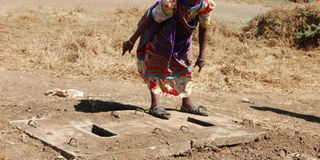Karamoja leaders decry low latrine coverage

Ms Mariam Ongole, an LCIII councillor representing Mogoth Parish in Rupa Sub-county, Moroto District, shows the abandoned toilet slab in Longoroko Village recently. Photo by Scovia Atuhaire
MOROTO- In Karamoja Sub-region, the culture of open defecation is a common practice due to lack of toilets.
A significant number of locals in the district still use bushes and other public places for easing themselves each time mother nature calls.
The lack of proper human waste management, however, has been blamed for the rampant diarrhoea and typhoid cases in Moroto District, arising from poor hygiene and sanitation.
According to the acting hospital director Moroto regional referral hospital, Dr Fred Ogwang, diarrhoea and typhoid are rampant in the district due to poor hygiene and sanitation as a result of open defecation.
Dr Ogwang says more than 50 cases of diarrhoea are registered monthly especially among children below five years and more than 20 typhoid cases are registered per month.
“Diarrhoea cases are common in children below five years and typhoid in adults between five and 59 years. This is as a result of poor hygiene and drinking contaminated water,” he told Daily Monitor in a recent interview.
As one slopes down Nakapelemen Village in Moroto municipality, people still use bush thickets to ease themselves.
Mr Charles Opolot, a resident of Longoroko Village, testifies that he has on several occasions treated his children for typhoid and diarrhoea as a result of consuming contaminated water.
Why the practice
Defending why they are not bothered going to bushes, Ms Rita Logilae, a resident of Longoroko Village in Rupa Sub-county, says they lack the means to construct toilets.
“We lack what to eat and therefore we cannot burn the little calories left to construct toilets,” she says.
She adds: “During the day, we go to the bushes and rivers to ease ourselves”.
When asked about what they use to clean themselves, Mr Logilae says they use leaves and stones and sometimes polythene bags but rarely wash their hands thereafter.
What then explains why the locals don’t utilise the toilets constructed by the government in the Sub-county?
Majority say they are not familiar with how they are used.
The former Local Council 1 chairperson, Nakapelimen Village, Mr Albino Labong, says because of the nature of their soils, constructing a toilet is expensive and most of the people do not use them.
He says people’s negative attitude towards toilets has also become a big challenge.
Government’s effort
Despite government’s efforts to drill boreholes as a means of providing people with safe water for drinking in the region, poor hygiene is still a challenge.
A recent UNICEF report indicates that diarrhoea accounts for 10 per cent deaths, or 33 deaths daily, of children below five years.
Karamoja’s pit-latrine coverage stands at 30 per cent, which is low compared to the national coverage of 77 per cent.
According to the guidelines issued by the Ministry of Health, every household must have a toilet.
According to 2017 Uganda water supply atlas, the Ministry of water and environment, water access in Moroto District is at 74 per cent. It has 333 domestic water points and one piped schemes which serve a total of 83,348 people – 69,626 in rural areas.
However, 75 water points have been non-functional for over five years and are considered abandoned.
Interventions by leaders
In November last year, Rupa Sub-county passed a by-law, barring any household that does not have a pit-latrine from benefitting from any government programme.
Some of the programmes include the Northern Uganda Social Action Fund, the Youth Livelihood Fund, the Women Empowerment Fund and the Social Assistance Grants for Empowerment.
The LCIII chairperson Rupa sub-county, Mr Apollo Dan Marijori, says despite the challenges, local leaders both at Sub-county and district level are trying their best to ensure that hygiene and sanitation are improved.
Mr Marijori says the low toilet coverage prompted them to institute the by-law.
“It’s a challenge to make our people accept to use latrines but we shall do all it takes to compel them to do so,” he says.
Population
Mr Godfrey Lotuk, the sub-county chief, says Rupa Sub-county has a population of 34,000 but only 1,000 use pit-latrines, while the rest defecate in open places.
Mr Lotuk says denying those without pit-latrines government services will force them to dig pit latrines.
He adds that the by-law was passed with support from Ecological Christian organisation in a bid to protect the environment for sustainable livelihood.
Recent statistics from the district health office indicate that only one per cent out of 108,456 residents wash hands after visiting latrines.
Dr Rews Andrew Ilukol, the Moroto District health officer, says more by-laws should be passed urgently to promote good hygiene in Karamoja Sub-region.
“We shall begin arresting everyone, including the district officials, who go around answering nature’s call in the bush, and charge them,” Dr Ilukol says.
Nationally, the districts of Kotido, Nakapiripirit, Moroto, Kaabong and Napak score poorly in sanitation and hygiene. These districts score below 40 per cent in comparison to the national target of 77 per cent.
2015 report
In the 2015 Sector Performance Report, the Ministry of Water and Environment attributes this poor state of sanitation and hygiene to a number of factors including negative cultural norms, available alternative defecation sites (bushes), limited funding for sanitation at local government level, and the limited community access to financial services to fund sanitation improvements.
Civil society organisations under Uganda Water and Sanitation NGO Network (UWASNET) are supporting communities in different parts of Uganda to embrace improved standards of sanitation and hygiene including ending open defecation.
The national umbrella organisation for all NGOs in the water and environment sector in Uganda, UWASNET is highlighting the dire status of sanitation and hygiene in the country and seeking partnerships to improve sanitation and hygiene in Karamoja region.



